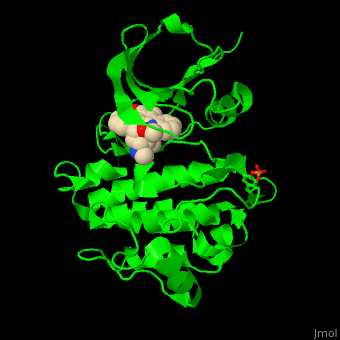Function
Tyrosine kinase (TK) transfers a phosphate group from ATP to tyrosine residues of proteins[1]. TKs are classified as receptor-TK which are membrane-attached and cytoplasmic non-receptor TKs. Staurosporine inhibits TK and prevents ATP binding to it.
For Abelson tyrosine kinase see:
For Bruton's tyrosine kinase see:
For Src tyrosine kinase[2] see:
For Kit tyrosine kinase (or SCF or stem cell factor) see:
For Tyk tyrosine kinase see:
For Focal adhesion kinase see:
- Focal adhesion kinase
- Csk tyrosine kinase (or C-terminal Src kinase) has a role in regulating apoptosis, survival, proliferation[3].
- Fgr tyrosine kinase has a role in regulating diet-induced obesity, insulin resistance and liver steatosis[4].
- Syk tyrosine kinase (or spleen tyrosine kinase) has a role in adaptive immun receptor signalling[5].
- Mer tyrosine kinase has a role in macrophage physiology like regulating cytokine secretion and clearance of apoptotic cells[6].
- Hck tyrosine kinase activates kinase-dependent and caspase-mediated apoptosis[7].
See also
For references see Treatments:TYKI References.
Relevance
Bcr-Abl inhibitors are used against chronic myelogenous leukemia (CLM)[8].
Disease
Mutated TK can cause unregulated growth of the cell and their inhibitors can be effective cancer treatment[9].
Structural highlights
TK contains, starting from the N-terminal, SH4 – a membrane attachment domain; SH3 and SH2 domains which are a sequence-specific phosphotyrosine binding domains with roles in protein-protein interactions and the SH1 catalytic kinase domain. The of Fyn TK which contains a , in the [10].
Traditional Chinese medicine as dual guardians against hypertension and cancer? [11]
functions as a signal protein and is implicated in various diseases. The carboxyl terminal of Src kinase is important in regulating conformation and activity of Src. Src protein is locked as an inward folding conformation through binding between the phosphorylated Tyr527 and the SH2 domain under normal inactive conditions. Src is activated when dephosphorylation of Tyr527 and phosphorylation of Tyr419 occurs.
From N-terminal to C-terminal, Src is composed of a (residues 270–340; colored in violet) which binds adenosine triphosphate (ATP) and a (residues 345–523; colored in green) which binds with substrates. The ATP binding site is also partially located in the larger lobe. By regulating the alpha-helix structure, the large lobe can move toward or away from the small lobe, opening or closing the cleft between the two lobes. The Src catalytic site is located within the cleft. An open conformation allows the entrance of ATP into the cleft and exit of adenosine diphosphate (ADP) from the cleft. Drugs that can either interact with the residues (404–432) on the activation loop or inhibit the activation loop from moving away and opening the cleft as a result of Tyr419 phosphorylation can effectively inhibit Src activity.
In this in vivo study, and have multiple stable interactions with the two Src cleft loops while simultaneously interacting with Asp407, hindering the activation loop from activation. Considering the aforementioned interactions with Src and high affinity with EGFR, HER2, and HSP90, we suggest that Angeliferulate and HMID which both originate from the TCM Angelica sinensis may have potential as multi-targeting drug leads.
3D structures of tyrosine kinase
Tyrosine kinase 3D structures
References
- ↑ Hubbard SR, Till JH. Protein tyrosine kinase structure and function. Annu Rev Biochem. 2000;69:373-98. PMID:10966463 doi:http://dx.doi.org/10.1146/annurev.biochem.69.1.373
- ↑ Roskoski R Jr. Src protein-tyrosine kinase structure and regulation. Biochem Biophys Res Commun. 2004 Nov 26;324(4):1155-64. PMID:15504335 doi:http://dx.doi.org/10.1016/j.bbrc.2004.09.171
- ↑ Fortner A, Chera A, Tanca A, Bucur O. Apoptosis regulation by the tyrosine-protein kinase CSK. Front Cell Dev Biol. 2022 Dec 12;10:1078180. PMID:36578781 doi:10.3389/fcell.2022.1078180
- ↑ Acín-Pérez R, Iborra S, Martí-Mateos Y, Cook ECL, Conde-Garrosa R, Petcherski A, Muñoz MDM, Martínez de Mena R, Krishnan KC, Jiménez C, Bolaños JP, Laakso M, Lusis AJ, Shirihai OS, Sancho D, Enríquez JA. Fgr kinase is required for proinflammatory macrophage activation during diet-induced obesity. Nat Metab. 2020 Sep;2(9):974-988. PMID:32943786 doi:10.1038/s42255-020-00273-8
- ↑ Mócsai A, Ruland J, Tybulewicz VL. The SYK tyrosine kinase: a crucial player in diverse biological functions. Nat Rev Immunol. 2010 Jun;10(6):387-402. PMID:20467426 doi:10.1038/nri2765
- ↑ Anwar A, Keating AK, Joung D, Sather S, Kim GK, Sawczyn KK, Brandão L, Henson PM, Graham DK. Mer tyrosine kinase (MerTK) promotes macrophage survival following exposure to oxidative stress. J Leukoc Biol. 2009 Jul;86(1):73-9. PMID:19386698 doi:10.1189/jlb.0608334
- ↑ Shivakrupa R, Radha V, Sudhakar Ch, Swarup G. Physical and functional interaction between Hck tyrosine kinase and guanine nucleotide exchange factor C3G results in apoptosis, which is independent of C3G catalytic domain. J Biol Chem. 2003 Dec 26;278(52):52188-94. PMID:14551197 doi:10.1074/jbc.M310656200
- ↑ Tolomeo M, Dieli F, Gebbia N, Simoni D. Tyrosine kinase inhibitors for the treatment of chronic myeloid leukemia. Anticancer Agents Med Chem. 2009 Oct;9(8):853-63. PMID:19538165
- ↑ Lengyel E, Sawada K, Salgia R. Tyrosine kinase mutations in human cancer. Curr Mol Med. 2007 Feb;7(1):77-84. PMID:17311534
- ↑ Kinoshita T, Matsubara M, Ishiguro H, Okita K, Tada T. Structure of human Fyn kinase domain complexed with staurosporine. Biochem Biophys Res Commun. 2006 Aug 4;346(3):840-4. Epub 2006 Jun 13. PMID:16782058 doi:10.1016/j.bbrc.2006.05.212
- ↑ Tou WI, Chen CY. Traditional Chinese medicine as dual guardians against hypertension and cancer? J Biomol Struct Dyn. 2012 Jul;30(3):299-317. Epub 2012 Jun 12. PMID:22694277 doi:10.1080/07391102.2012.680030

